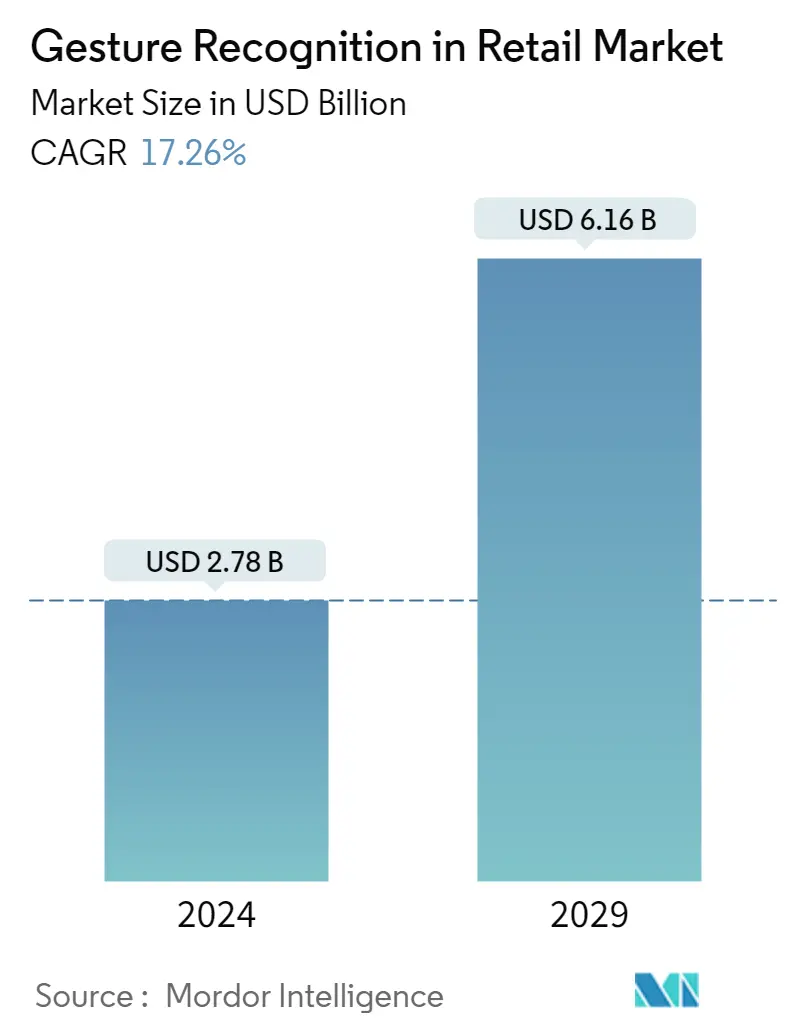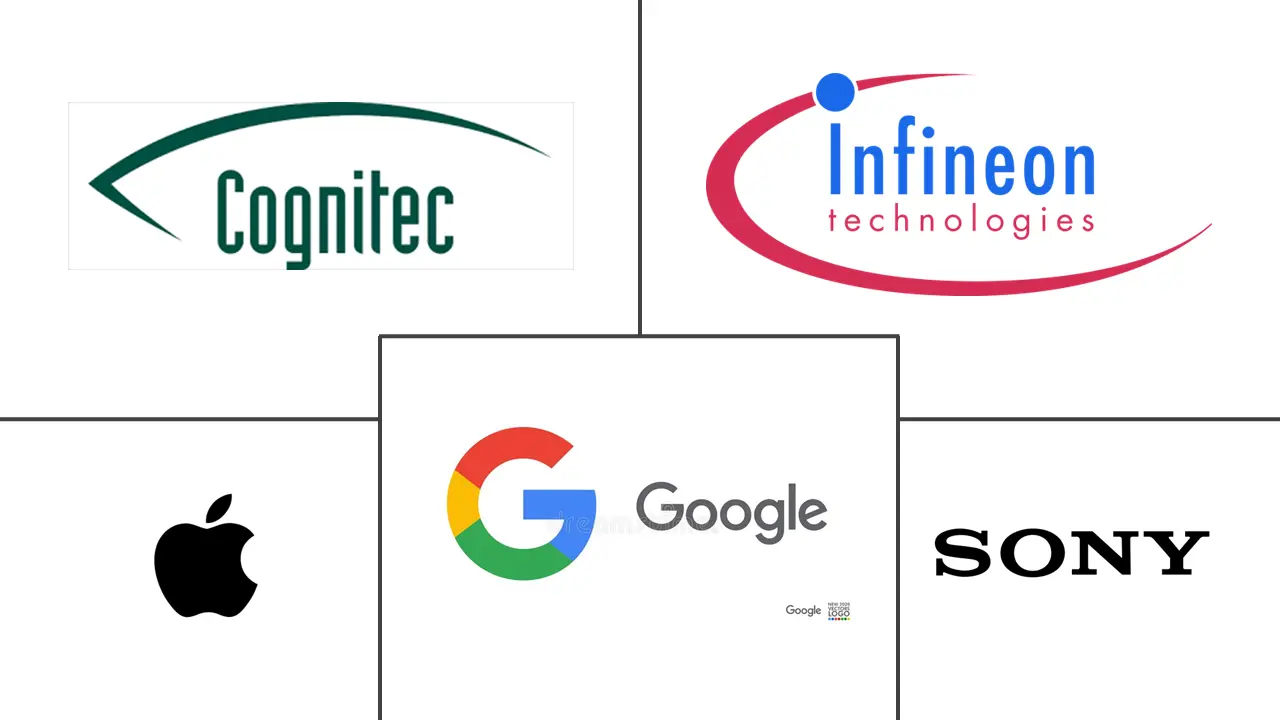Market Size of Gesture Recognition in Retail Industry

| Study Period | 2019 - 2029 |
| Market Size (2024) | USD 2.78 Billion |
| Market Size (2029) | USD 6.16 Billion |
| CAGR (2024 - 2029) | 17.26 % |
| Fastest Growing Market | Asia Pacific |
| Largest Market | North America |
| Market Concentration | Low |
Major Players
*Disclaimer: Major Players sorted in no particular order |
Gesture Recognition in Retail Market Analysis
The Gesture Recognition in Retail Market size is estimated at USD 2.78 billion in 2024, and is expected to reach USD 6.16 billion by 2029, growing at a CAGR of 17.26% during the forecast period (2024-2029).
The market will likely benefit from rising global per capita income, technological developments, and more digitization in the retail industry. The expanding use of the Internet of Things (IoT) and the growing need for comfort and convenience in product consumption are also driving market expansion.
As per the Global Alliance for Improved Nutrition, there will be around 13 million retail food stores in India by 2022. This included both conventional and new merchants within the sector. While there has been consistent growth since 2013, it has been chiefly constituted of traditional retailers. Many retail establishments would provide opportunities for the studied market to expand. Various prototypes have been created to make hand gesture detection more affordable than conventional interface tools like keyboards and mice. Hand gestures are highly expressive, easily interact with the environment, and effectively transmit information may cause leading suppliers' rising interest.
Reliable personal recognition is required by a wide variety of access control systems. Examples of these systems include ATMs, laptops, and cellular phones. If these systems fail to meet the demands of reliable and robust authentication, potential imposters may gain access to these systems. To enhance the security of access control systems, two-factor authentication (T-FA) has been introduced, wherein two factors are combined to authenticate a user. Such factors are expected to drive the studied market.
Further, retailers can use facial recognition technology to create faster and more frictionless transactions, increase customer satisfaction through rich analytics, offer targeted advertising, better manage employee attendance and store security, and personalize experiences for VIPs and loyalty program members. Investments in smart retail technology will guarantee that merchants continue giving the best in-store experience possible, improving brand loyalty and sales.
The capacity of computers to visually recognize hand movements is critical for the future development of HCI. However, vision-based recognition of hand gestures, particularly dynamic hand gestures, is a difficult interdisciplinary challenge for three reasons: hand gestures are diverse, have multiple meanings, and vary spatiotemporally; the human hand is a complex non-rigid object that is difficult to recognize; and computer vision is an ill-posed problem in and of itself.
The COVID-19 pandemic made contactless communication essential. Gesture recognition, which was relegated to AR/VR and biometric authentication background, benefited from this. The market had a lot of room for growth if platform-independent gesture detection systems were developed. Additionally, consumers' familiarity with AR/VR systems and the minimum interaction required with screens can broaden its application in various industries. Smartphones and the advertising space worked together to seamlessly transmit relevant ads and deliver information in the digital sphere.
This is in response to numerous smart city projects that would be implemented in various nations.
Gesture Recognition in Retail Industry Segmentation
Gesture recognition is the ability of a device to identify and respond to the different gestures of an individual. Gesture recognition is expected to provide a new dimension to window shopping. Moreover, it will enable shoppers to find their preferred products with a simple wave of the hand, allowing them to search for a specific product using a touchless PC monitor (digital catalog).
Gesture Recognition in Retail Market is segmented by technology (Touch-based, Touch-less) and geography (North America, Europe. Asia Pacific, Latin America, Middle East, and Africa).
The market sizes and forecasts are provided in terms of value (USD) for all the above segments.
| By Technology | |
| Touch-based Gesture Recognition | |
| Touch-less Gesture Recognition |
| Geography | |
| North America | |
| Europe | |
| Asia-Pacific | |
| Latin America | |
| Middle East & Africa |
Gesture Recognition in Retail Market Size Summary
The gesture recognition retail market is poised for significant growth, driven by advancements in technology and increasing digitization within the retail sector. The market is expected to expand substantially over the forecast period, benefiting from the rising global per capita income and the growing integration of the Internet of Things (IoT). The demand for touchless and gesture-based interactions is gaining momentum, particularly in the wake of the COVID-19 pandemic, which has accelerated the adoption of contactless communication solutions. Retailers are increasingly leveraging gesture recognition technologies to enhance customer experiences, streamline transactions, and improve security measures. This trend is further supported by the development of more affordable and efficient hand gesture detection systems, which are becoming more appealing to leading suppliers.
The market landscape is characterized by a fragmented competitive environment, with key players such as Sony Corporation, Apple Inc., and Google LLC actively engaging in product launches, research and development, and strategic partnerships to maintain their market positions. Innovations in gesture recognition technology, including 3D gesture tracking algorithms and AI-driven sign language translation platforms, are paving the way for new applications and opportunities in the retail space. As retailers continue to invest in smart technologies to enhance in-store experiences and drive sales, the gesture recognition market is expected to witness robust growth, supported by the increasing demand for personalized and efficient shopping experiences.
Gesture Recognition in Retail Market Size - Table of Contents
-
1. MARKET DYNAMICS
-
1.1 Market Overview
-
1.2 Introduction to Market Drivers and Restraints
-
1.3 Market Drivers
-
1.3.1 Increasing Dependence on Gestures to Communicate with Machines
-
1.3.2 Increasing Use of Devices Supporting Gesture Recognition Across the Retail Sector
-
-
1.4 Market Restraints
-
1.4.1 Algorithms, Mathematical and Other Complexities Associated with the Gesture Recognition Technology
-
-
1.5 Industry Value Chain Analysis
-
1.6 Industry Attractiveness - Porter's Five Forces Analysis
-
1.6.1 Threat of New Entrants
-
1.6.2 Bargaining Power of Buyers/Consumers
-
1.6.3 Bargaining Power of Suppliers
-
1.6.4 Threat of Substitute Products
-
1.6.5 Intensity of Competitive Rivalry
-
-
-
2. MARKET SEGMENTATION
-
2.1 By Technology
-
2.1.1 Touch-based Gesture Recognition
-
2.1.2 Touch-less Gesture Recognition
-
-
2.2 Geography
-
2.2.1 North America
-
2.2.2 Europe
-
2.2.3 Asia-Pacific
-
2.2.4 Latin America
-
2.2.5 Middle East & Africa
-
-
Gesture Recognition in Retail Market Size FAQs
How big is the Gesture Recognition in Retail Market?
The Gesture Recognition in Retail Market size is expected to reach USD 2.78 billion in 2024 and grow at a CAGR of 17.26% to reach USD 6.16 billion by 2029.
What is the current Gesture Recognition in Retail Market size?
In 2024, the Gesture Recognition in Retail Market size is expected to reach USD 2.78 billion.

